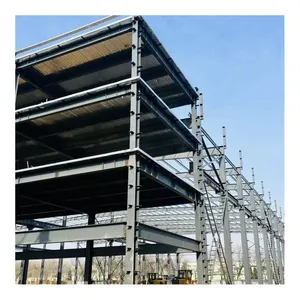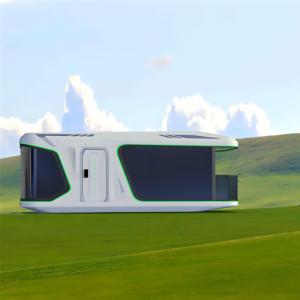Modular Factories



































































 CN
CN









About modular factories
Where to Find Modular Factories Suppliers?
China leads global production of modular factory solutions, with concentrated manufacturing hubs in Shandong, Hunan, and Hebei provinces offering distinct regional advantages. Shandong's Jinan and Qingdao clusters specialize in steel-structured and container-based modular units, leveraging proximity to port infrastructure for streamlined export logistics. Hunan and Hebei regions focus on customizable prefabricated industrial buildings, supported by integrated supply chains for sandwich panels, structural steel, and insulation materials.
These industrial zones enable vertically integrated production—from raw material processing to final assembly—reducing component lead times by 20–30% compared to decentralized manufacturing models. Buyers benefit from consolidated ecosystems where design, fabrication, and quality control occur within co-located facilities. Key sourcing advantages include scalable output (monthly capacities exceeding 10,000 m² per major supplier), 15–25% cost efficiency over Western manufacturers, and flexibility for both standardized and engineered-to-order configurations.
How to Choose Modular Factories Suppliers?
Implement rigorous evaluation criteria when selecting suppliers:
Technical and Structural Compliance
Verify adherence to international building standards such as ISO 9001 for quality management and CE marking for structural safety. For seismic or high-wind regions, confirm compliance with local engineering codes (e.g., MBMA, ASCE 7). Request detailed load-bearing calculations, fire resistance ratings, and thermal performance data (U-values) for wall and roof systems.
Production Capacity Assessment
Evaluate core operational metrics:
- Minimum factory area of 10,000 m² for large-scale orders
- In-house capabilities in CNC cutting, automated welding, and panel lamination
- Dedicated R&D teams for custom layout and utility integration
Cross-reference declared capacity with on-time delivery records (target ≥95%) and reorder rates to validate reliability.
Customization and Transaction Security
Prioritize suppliers offering full design flexibility—including floor plans, cladding materials, window/door placement, and electrical/plumbing pre-installation. Confirm support for BIM or CAD modeling. Use secure transaction mechanisms such as escrow services, and request third-party inspection reports (e.g., SGS, BV) before shipment. Pre-shipment audits should verify dimensional accuracy and finish quality against approved drawings.
What Are the Best Modular Factories Suppliers?
| Company Name | Location | Main Products | Customization Options | On-Time Delivery | Avg. Response | Min. Order | Price Range (USD) | Reorder Rate |
|---|---|---|---|---|---|---|---|---|
| Shandong Suninn Intelligent Technology Co., Ltd. | Shandong, CN | Container Houses (615), Other Prefab Houses (372) | Color, material, size, logo, packaging | 100% | ≤4h | 18 m² | $190–218/m² | - |
| Qingdao Sunlit International Trade Co., Ltd. | Shandong, CN | Folding Container Units, Modular Steel Structures | Color, material, size, logo, packaging, graphics | 100% | ≤2h | 1 set | $520–1,400/set | <15% |
| Hunan Kinge Construction Technologies Co., Ltd. | Hunan, CN | Modular Multi-Family Homes, Military Units | Color, material, size, logo, packaging, graphics | 100% | ≤5h | 1 unit | $500–3,999/unit | - |
| JINAN RUNYU NEW MATERIAL CO., LTD | Shandong, CN | Container Houses (4,601), Portable Toilets | Size, layout, cladding | - | ≤1h | 1 set | $999–8,988/set | - |
| Hebei Xiangyu Container Co., Ltd. | Hebei, CN | Expandable Containers, Prefab Houses | Design, size, hurricane-proof features | 100% | ≤3h | 1 m² | $120–2,000/unit or m² | - |
Performance Analysis
Shandong-based suppliers demonstrate superior responsiveness and delivery consistency, with three providers achieving 100% on-time fulfillment. Shandong Suninn and Qingdao Sunlit offer competitive pricing for volume buyers, with low MOQs starting at 18 m² or per set. JINAN RUNYU stands out in product volume, listing over 4,600 container house variants, indicating robust production scalability. Hebei Xiangyu provides the lowest entry barrier with a 1 m² minimum order, ideal for prototyping or small installations. While reorder rate data is limited across most suppliers, consistent response times under 5 hours suggest strong customer service infrastructure. Prioritize suppliers with documented customization workflows and verifiable project portfolios for mission-critical deployments.
FAQs
How to verify modular factory supplier reliability?
Validate certifications through issuing bodies and request factory audit reports covering design validation, welding standards, and corrosion protection processes. Analyze shipment history and customer feedback focusing on structural integrity post-installation and after-sales technical support.
What is the typical lead time for modular factory units?
Standard units require 30–45 days for production and preparation. Custom designs with integrated MEP systems may take 60–75 days. Add 15–30 days for international sea freight depending on destination port.
Can modular factories be expanded or relocated?
Yes, most modular units are designed for disassembly, transport, and reconfiguration. Confirm connection system compatibility (bolted vs. welded joints) and foundation requirements for future modifications during initial procurement.
Do suppliers provide installation guidance or turnkey services?
Many suppliers offer site supervision, crane-assisted assembly blueprints, and optional technician dispatch. Turnkey packages typically include foundation design, utility hookups, and commissioning support—clarify scope and associated costs upfront.
What materials are commonly used in modular factory construction?
Primary structures use galvanized steel frames with EPS, rock wool, or polyurethane sandwich panels for walls and roofs. Flooring often includes cement boards or steel decks with anti-slip coatings. Ensure material specifications meet fire safety (A-class non-combustible) and insulation requirements for intended climate zones.











































































































































